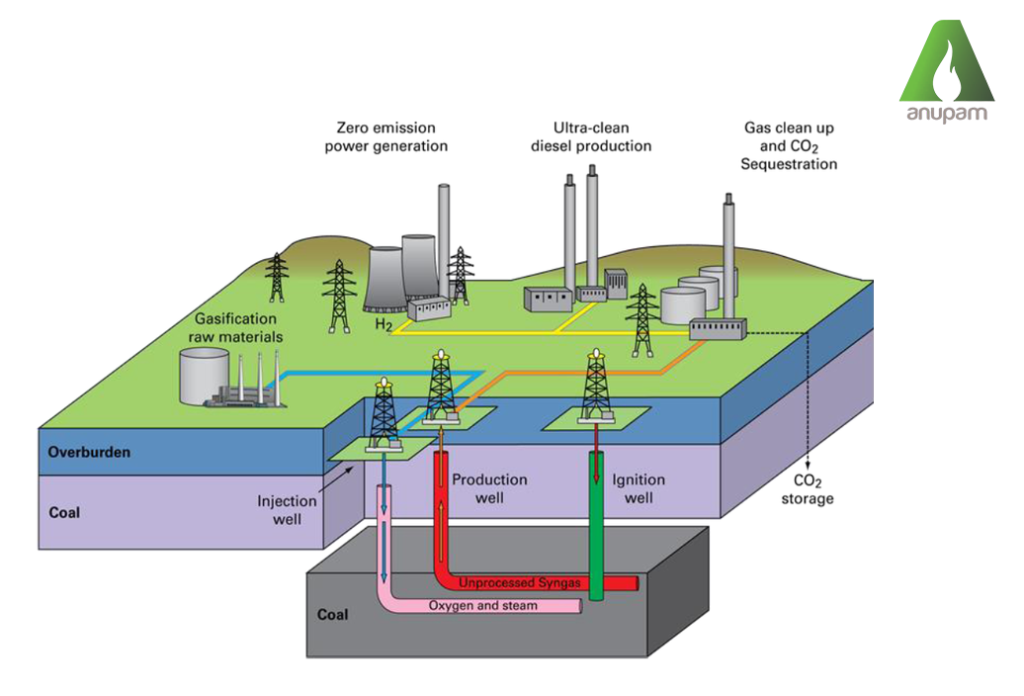
The world is at a crossroads when it comes to energy production. While fossil fuels remain a dominant source, their environmental impact is undeniable. However, what if there was a way to extract energy from coal without the massive carbon footprint of traditional mining and combustion? Enter Underground Coal Gasification (UCG) – a technology that has the potential to revolutionize energy production while addressing environmental concerns.
But is it truly the future of cleaner fossil fuels, or just another energy experiment?
What is Underground Coal Gasification (UCG)?
Underground Coal Gasification (UCG) is a method of converting coal into a combustible gas (syngas) while it is still in the ground. Instead of mining coal, UCG injects oxygen and steam into coal seams through boreholes, triggering a chemical reaction that produces syngas—a mixture of hydrogen, carbon monoxide, methane, and carbon dioxide.
This gas can be extracted and used for electricity generation, chemical production, or even liquid fuels, offering an alternative to traditional coal mining and combustion.
How Does UCG Work?
The process involves four key steps:
- Injection: Oxygen and steam are injected into an underground coal seam.
- Gasification: Heat and pressure cause a chemical reaction, breaking down coal into syngas.
- Extraction: The syngas is brought to the surface through production wells.
- Processing & Utilization: The extracted syngas is cleaned and used for power generation, fuel synthesis, or industrial applications.
The Advantages of UCG
🚀 Reduced Environmental Impact: Unlike traditional coal mining, UCG eliminates the need for surface excavation, reducing land degradation and air pollution.
💧 Water Conservation: Conventional coal mining consumes large amounts of water, whereas UCG reduces water contamination and wastage.
💰 Cost-Effective: Since it avoids expensive mining operations, UCG can be more economical, especially for deep or unmineable coal seams.
⚡ Versatile Energy Production: The syngas produced can be used for electricity, hydrogen fuel, and synthetic natural gas.
🌍 Lower Greenhouse Gas Emissions: UCG reduces direct coal combustion, cutting down on CO₂ emissions when coupled with carbon capture technology.
The Challenges and Risks
- Carbon Storage Issues: Without carbon capture and storage (CCS), the emissions from syngas combustion can still contribute to climate change.
- Groundwater Contamination: If not carefully managed, underground reactions may release harmful substances into water sources.
- Geological Risks: Underground cavities left by gasification could lead to land subsidence, affecting nearby infrastructure.
The Future of UCG : Game Changer or Gimmick?
With growing investments in cleaner energy, several countries—including Australia, China, and the U.S.—are experimenting with UCG projects. However, large-scale adoption depends on addressing environmental concerns and advancing carbon capture technologies.
The Verdict : A Step Forward or a Step Back?
While UCG presents an exciting alternative to traditional coal usage, it is not a silver bullet. The future of energy will likely involve a mix of renewables, nuclear, and cleaner fossil fuel technologies like UCG.
The question is : Will industries and policymakers prioritize innovation to make UCG a viable bridge to a cleaner energy future?
